带绕组导体段的变压器液体在雷击下的击穿特性
IF 3.1
3区 工程技术
Q2 ENGINEERING, ELECTRICAL & ELECTRONIC
IEEE Transactions on Dielectrics and Electrical Insulation
Pub Date : 2025-01-16
DOI:10.1109/TDEI.2025.3530905
引用次数: 0
摘要
从历史上看,变压器绝缘设计是基于矿物油(MO)的经验。基本绝缘等级(BIL)决定了特定设计的耐雷击等级(LIWL)。这些设计值不一定适用于MO以外的其他绝缘液体。在设计相关绝缘几何形状时使用非矿物基液体的BIL的已发表研究很少。本研究比较了合成酯(SE)液体和气转液(GTL)油的雷击击穿电压(BDVs)与使用绕组导体作为电极几何形状的MO的雷击击穿电压(BDVs)。在所有情况下,裸电极的场增强系数都小于4.1,表明具有准均匀场。考虑了液体间隙距离、纸张包裹和脉冲极性的影响。研究发现,交替变压器液体的LI bdv与MO相当,并捕获了击穿过程中的流光传播特性。结果表明,在正LI条件下,击穿是由快速流光引起的,而在负LI条件下,则存在流光模式的转变。bdv被发现几乎是相同的极性,他们几乎不同的三个研究变压器液体。这是因为在目前的测试电极几何形状和条件下,击穿主要是由流光引发的。本文章由计算机程序翻译,如有差异,请以英文原文为准。
Breakdown Characteristics of Transformer Liquids With Winding Conductor Segments Under Lightning Impulse
Historically, transformer insulation design is based on experience with mineral oil (MO). The basic insulation level (BIL) determines the lightning impulse withstand level (LIWL) for a specific design. These design values are not necessarily appliable to other insulating liquids than MO. There are few published studies on BIL using nonmineral-based liquids in design-relevant insulation geometries. The present study compares lightning impulse (LI) breakdown voltages (BDVs) of a synthetic ester (SE) liquid and a gas-to-liquid (GTL) oil with those of MO using winding conductors as electrode geometries. The field enhancement factors for the bare electrodes are below 4.1 in all cases indicating the quasi-uniform fields. The effects of liquid gap distance, paper wrapping, and impulse polarity are all considered. It is found that the LI BDVs of the alternative transformer liquids are comparable to those of the MO. The streamer propagation characteristics during the breakdown process are also captured. The results show that the breakdowns are led by the fast streamer under positive LI, and there is a streamer mode transition under negative LI. The BDVs are found to be practically the same for both polarities, and they barely differ among the three investigated transformer liquids. This is because the breakdowns are dominated by the streamer initiation under the present test electrode geometries and conditions.
求助全文
通过发布文献求助,成功后即可免费获取论文全文。
去求助
来源期刊
CiteScore
6.00
自引率
22.60%
发文量
309
审稿时长
5.2 months
期刊介绍:
Topics that are concerned with dielectric phenomena and measurements, with development and characterization of gaseous, vacuum, liquid and solid electrical insulating materials and systems; and with utilization of these materials in circuits and systems under condition of use.

 求助内容:
求助内容: 应助结果提醒方式:
应助结果提醒方式:


